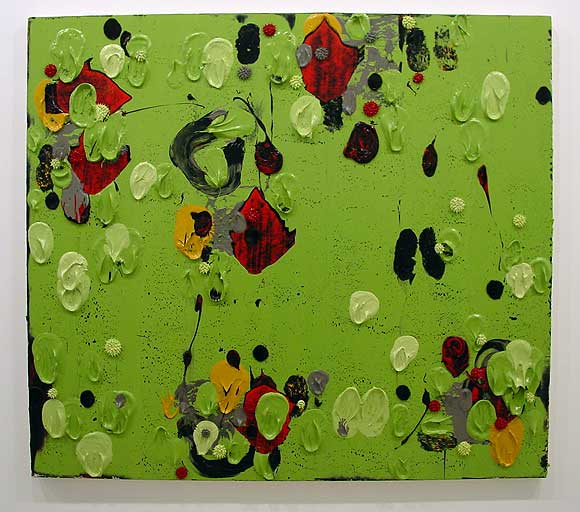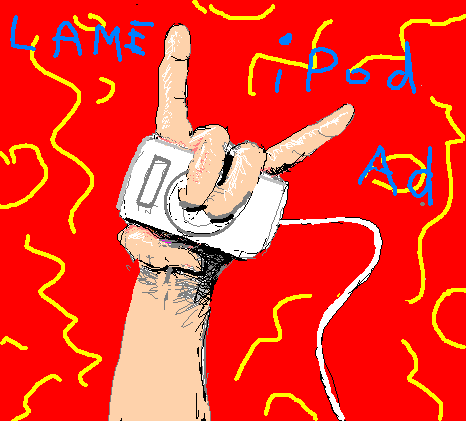View current page
...more recent posts
"Acid Casualty" [mp3 removed]
Two of my favorite CDs are 808 State's Newbuild, which is acid house made when A Guy Called Gerald was still in the group and before they "got it down" and started producing club smashes, and the collection Acid Classics, on Trax records, which is all the best stuff from Chicago in 1986-88. I love the intensity of the music and also the "I made it at home" quality. Tried to do something in that spirit here (although the synth used in the "break" is a bit more '92 hardcore rave.) No one can accuse me of being nostalgic for acid house because I had no idea it existed in '88--at least not the wack form you hear on Newbuild. I was on board by the early '90s, but by then the music had already mutated into something else. Interesting to think back to pre-Internet days--how slowly it took scenes to find their way to their potentially most enthusiastic audiences.
Tristero at Hullabaloo has dinner with a "liberal hawk":
"No, no, let me ask you a question. How come you, a musician, maybe a good one, maybe a well-read one, but a musician with no training in affairs of state - how come you of all people were right about Iraq but the most respected, most experienced, most intelligent, most serious thinkers in the United States got it wrong?"We have a liberal hawk who used to post a fair amount here at Digital Media Tree, and I had some lively debates with him during that period when America was going off a cliff. Unlike tristero's hawk, he didn't question my credentials to question the war, but he did a lot of scaremongering. "What if Saddam nuked the Saudi oil fields?" "Saddam or Osama (I forget which boogeyman) wants to establish a New Caliphate and rule the Middle East!" (Or words to that effect.) What it came down to was he believed ex-CIA analyst Kenneth Pollack about Iraq, and I believed ex-UN weapons inspector Scott Ritter, who had been in the country and said it had no weapons of mass destruction. Also, unlike tristero's defensive hawk, the Tree's hawk doesn't continue to defend his judgment. He's just been very quiet the past couple of years. It's a shame--he's a bright, knowledgeable guy and I miss our debates.
"That is a question I ask myself every day, because it scares the daylights out of me," I replied.
My eyes started to tear up and the winter of 02/03 raced through my head. That awful sense of dissociation watching every American media outlet try to outdo its rivals by printing lies, the unspeakable dread as I watched my country willingly go over the abyss. The shock of realizing that nearly everyone I knew had bought the myth of the Good War and that nothing I could say or do, nothing anyone could say or do could change their mind. It was too late.
I tried to say more, but I couldn't, and then the subject changed and the dinner went on.

Just got back from Dennis Hollingsworth's opening at Nicole Klagsbrun in Chelsea, where I took this pic of one of Hollingsworth's paintings, and met the artist for the first time. Nice guy, but I knew that from his blog (still a comparative rarity--a generous walk around his life and studio). The photo makes the piece look small, but this is about 4-5 (?) feet wide. I like Dennis's work and have enjoyed watching it evolve on the Web. Nothing like seeing the real thing, though. I think you can get from the photo how sumptuous it is. What you don't get is the complex interplay of layers, and the gritty, gestural quality that invokes Pollock as well as taggers. These aren't facile paintings, you sense a lot gets scraped off before they start working. Earlier posts on Hollingsworth are here and here.
Digital Non-Sites
A few years ago I was in a show in Washington DC called "Digital Sites," which featured artists from the gallery side of things who use the computer in their practice (Albert Oehlen, Matt Mullican, Wayne Gonzales, Marsha Cottrell, etc.)
Response from the art world was flat, as these things usually are--minimal sales as far as I know, a couple of sniping or dismissive reviews. In 1999 I did not yet realize the depth of the "computers do not belong in the art world" conspiracy and couldn't have foreseen that painting would tighten its grip on the market to the extent it has. I mean, I like Dana Schutz's work, but it's just recycled German Expressionism, yet collectors are treating it like spun platinum.
The title "Digital Sites" was good, riffing on the dual meaning of the term "sites"--as in web sites, but also site specificity. The latter had its roots in the practice of earthworks artist Robert Smithson, who also came up with the term "Non-Sites," which are physical pieces, such as minerals from a quarry hauled into the gallery and displayed in a metal container.
Lately in my work, including the solo show that's up now, I've been experimenting with the idea of "Digital Non-Sites." In other words, content that lives and thrives on the Internet, such as animated GIFs, that has a second, qualitatively different life in the gallery. This could either be video or drawings of individual animation frames I've been posting.
That's the theoretical hook anyway. *crickets*
Last night the artist team JODI (Joan Heemskerk and Dirk Paesmans) presented their 2-channel video Max Payne Cheats Only at Electronic Arts Intermix in Chelsea. One of the earlier and still best "net artists," JODI favors anarchy, entropy, and irony over the world-bridging utopianism of much net practice; their site jodi.org famously, creatively dismantles itself (and your browser) as you use it. Max Payne Cheats Only wreaks similar havoc with the realistic "film noir" videogame Max Payne, concerning an Everyman who enters the underworld seeking Charles Bronson-style revenge after a criminal gang kills his family. The JODI version consists entirely of "cheats"--shortcuts and fragments of imagery buried in the code that are widely disseminated via (company sponsored) fan websites. Physics and perspective-flouting manipulations such as: Max walking through a wall when he gets cornered by the bad guys; Max becoming magically bulletproof--but also fun stuff like making the gangster's moll run around naked.
JODI reassembles the cheats' fragments and freaky camera angles with the manic verve of a sadistic child playing with dolls in a Dr. Caligari-like dollhouse, opting for maximum disorientation and grotesqueness. Thus, Max pounds the floor endlessly with a lead pipe, rapidly changing characters run headfirst into the same stretch of wall, the nude moll pirouettes like a ballerina in "bullet time," faces are stripped of skin and muscle leaving gaping, floating dental work. The vids meld the psychic fragmentation of Hannah Hoch's collages, the pointless headbanger repetitions of Paul McCarthy videos, and the claustrophobic worlds-within-worlds of Cronenberg's Videodrome or ExistenZ.
This work appeared a few months ago in PaceWildenstein Gallery's "Breaking and Entering: The Art of the Videogame," which exhibited it incorrectly, we learned. It's meant to be viewed flat on a wall with the audience seated; instead, the gallery displayed it on a cross-shaped wooden partition constructed for another, unshown piece (a four channel video of cars obsessively circling on grass, asphalt, and in the sky). By projecting the 2-channel Max Payne on the four-walled construction (using a couple of backup Payne DVDs to expand the video from two to four projections), PaceWildenstein in effect created a third work, which the artists, who live in Europe, didn't find out about till after the show's end. It's a shame, because the "cars circling" vids, a couple of which were shown last night, would have been impressive in a gallery space. They are repetitive and "ambient" as opposed to long and "linear" and thus more appropriate to show in a physical setting where viewers walk around and are unlikely to stand and watch for long.
A bit of drama: Right at the point in the panel last night when the artists and attendees were mulling over what PaceWildenstein could possibly have been thinking (were they sloppy, high-handed, or both?), someone (a dealer, I was told) angrily interjected from the audience that the speculation and criticisms regarding the gallery were inappropriate. "Of course they were negligent, we don't need to discuss it," he declared. Rather weird. Fun panel--thanks to Caitlin Jones for moderating and EAI and Rhizome.org for hosting this event.
An earlier post on JODI is here.
The fruits of my video and music collaboration with John Parker will be on view this Fri, May 12, in Toronto. The exhibition is Mods and Rockers, curated by Sally McKay as part of digifest 2006: mods:
Artist teams are:And here is the statement for our piece, anti-phallically titled Rodmocker, which will be displayed on two TV screens with an asynchronous music soundtrack on CD, playing through headphones:
* Myfanwy Ashmore & Lorna Mills
* Chandra Bulucon & Andrew J. Paterson
* Rob Cruickshank & Veronica Verkley
* Tom Moody & John Parker
In Britain in the 1960s, mods and rockers frequently clashed in bloody battles. For this exhibition, however, we ask them to merge in the name of art. Four pairs of artists, one Mod and one Rocker per team, will collaborate on art, video and sound works that illuminate the polarities of the partnership.
Tom Moody and John ParkerThe work was composed in public, on this blog, over the span of about a month. The posts are documented on John's site eyekhan.com.
Rather than have some kind of face-off, or rumble, we are merging sensibilities. The collective inner Mod is the high tech influence in the form of some sophisticated audio software and a newish laptop used to edit and burn the video, and the inner Rocker is the low tech source material: 8-Bit-style tunes on an old Mac (some originally composed in the '80s) and animated GIFs by Tom based on MSPaint versions of Web images of John's work.
We're trying for some sort of parity between the audio and visual material. Pixels and square waves are both medium and subject.
If you're in the Toronto area, I hope you will check it out!

TV sketch artist, documenting the atrocities...
Thor Johnson remixed a piece of mine posted a few months ago:
"Tasteful Triphop (Thorrific Shruti Box Remix)" [mp3 removed].
The original tune is here:
"Tasteful Triphop" [mp3 removed].
Johnson's version is darker and more haunted. It is no longer tasteful, but instead might be described as a combination of Lou Reed's Metal Machine Music and Can's "ethnographic forgery series," with a modern but gritty digital edge.
Johnson also has a new web video (approx 24 MB Flash file), a psychedelic montage of Dick Cheney's recent, much-booed "throwing out the first pitch" photo op with the debated-and-then-quickly-forgotten clip of American soldiers shooting the wounded in Fallujah. The repressed returns to mingle with the banality of evil (that baseball jacket!).
